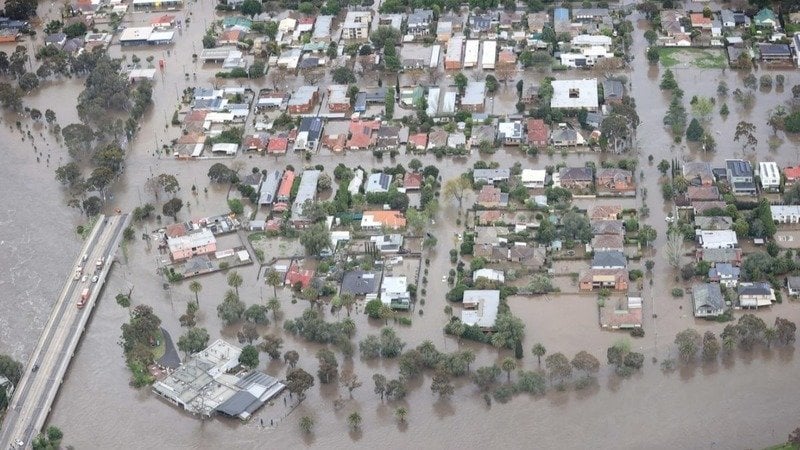Maribyrnong Flood Recovery and Prevention

In October 2022, record-breaking rain in Victoria led to the Maribyrnong River breaching its banks. Hundreds of City of Maribyrnong residents were displaced and more than 500 properties were significantly impacted.
Despite a significant recovery effort, many people were unable to return to their homes for months and some are still experiencing ongoing challenges related to insurance and repairs.
Council seeks State and Federal Government support to help address various issues still impacting community members affected by the 2022 Maribyrnong flood and to implement measures to prevent or mitigate future flood damage.
The broad nature of issues has resulted in five sub priorities:
Resilient Rebuilding Programs
The economic costs of flooding go beyond immediate damages. Business interruptions, job losses, and recovery expenses place a heavy burden on the community. A comprehensive report into the financial impacts will help quantify the costs of recovery on local business, residents and government.
This is a priority identified by the Maribyrnong Community Recovery Committee. and will encourage residents and businesses to take appropriate steps to prepare for emergencies and validate the experiences of this community. Quantifying the impact will also provide a clear understanding of the scope of the issue, which is required to determine options to mitigate future impacts.
Our Ask
Local economic impact report
Council calls on the State Government to deliver a comprehensive report into the economic impacts of the October 2022 flood event on residents, businesses, local, state and federal government.
Insurance Viability and Case Handling
Community-needs assessments undertaken as part of the Maribyrnong Insurance Project provided a range of adverse insurance experiences involving Maribyrnong residents following the October 2022 floods.
Many of the experiences collated through the needs assessment process involved insurance availability and affordability, unreasonable premium increases, and woeful delays during the claims process, and the inability to adapt homes to be more flood resilient.

Such experiences have been echoed by the many inquiries, reports, and recommendations made to address these issues since 2022, including the Flood Failure to Future Fairness Report, which includes recommendations from the Parliamentary Inquiry into Insurers’ Responses to 2022 Major Floods; and Unsettled: Climate Risk and Cash Settlements in Home Insurance from Financial Counselling Victoria.
Consumers should be able to trust insurers to be there when the worst happens, which is why the Federal Government must ensure that policies surrounding house insurance and natural disaster claims put the consumer before the insurance companies.
More affordable and reliable insurance coverage is needed, along with flood resilience and mitigation measures, to prevent acute personal hardship, and prohibitive recovery and social welfare costs to taxpayers and ratepayers.
Our Ask
Overhaul of the flood insurance process to make it more available, affordable and consumer friendly
Council seeks:
- Federal Government funding for schemes that address insurance availability and affordability, such as an insurance subsidy for vulnerable or at-risk residents or a national insurance scheme.
- Stronger regulations to improve the handing of claims (including one case manager through the whole case, where possible; product disclosure statements in plain language and translated; proactive personal support from insurance companies for an affected region; and regulation of unreasonable increase of premiums.
- Funding for a database of specialist builders to be available free of charge to the community to validate insurance scope of works documents.
Emergency Early Warning System
Early warning systems are critical for providing timely and effective information to enable communities and services to take action to prepare for emergencies. The Australian Warning System (AWS) has made improvements in consistency of emergency warnings, however there is a need for continuous improvement.
The October 2022 Flood of the Maribyrnong River took many residents off-guard, with reports of residents not aware of the flood warning until water had entered their homes. A review of the existing system and implementing improvements would enhance residents’ capacity to act early to protect themselves and their property.
Embedding a review of the flood warning system into its transition from Melbourne Water to the Bureau of Meteorology would provide an opportunity to enhance the accuracy and timeliness of flood warnings and mitigate the impacts of increasingly frequent and severe disasters on communities.
Finally, accessibility of systems is critical to meet the needs of communities that face barriers receiving and interpreting information. Public education is crucial to increase awareness of how to respond to warnings, promoting community resilience.
Recommendation 45 of the State Government's The 2022 flood event in Victoria report calls to improve the flood warning system so that warnings are:
- accurate with the most up-to-date information
- delivered in a timely way
- clear and easily understood
- consistently disseminated across different communities
- accessible in relevant formats and languages, where appropriate
Our Ask
Enhance early warning infrastructure and flood warnings
Council calls on the Federal Government provides additional funding and support for research and enhancement of comprehensive early warning systems for emergencies across Australia, including:
- Allocate additional funding for research, development, and implementation of advanced early warning systems across Australia to improve accuracy and timeliness of warnings.
- Review and enhance the flood warning system as part of the transfer of this function from Melbourne Water to the Bureau of Meteorology, with an emphasis on warning accuracy and timeliness.
- Continue to promote the integration of early warning systems with emergency management frameworks and communication channels to enable stakeholder collaboration and seamless dissemination of warnings.
- Consider the accessibility needs of at-risk communities in system improvements, including the culturally and linguistically diverse community.
- Invest in accessible public education campaigns to raise awareness about effectively responding to warnings.
Flood Mitigation Infrastructure
The October 2022 flood caused significant damage to homes, businesses, infrastructure, and the environment, displacing residents and disrupting local economies.
Many affected communities are still recovering from this trauma, and the risk of future flooding remains high due to climate change and shifting weather patterns. Investment is necessary to address the vulnerabilities exposed by this event and prevent future catastrophic damage.
With population growth and development, as well as the increasing frequency and severity of extreme weather events driven by climate change, the risk of flood impacts grows.
Without investment in mitigation measures, this growth will exacerbate the damage from future floods, putting more people at risk. Investment in flood mitigation now can protect the community in the face of future flooding and reduce long-term recovery costs.
Investment in mitigation will also enhance the resilience of the local economy.
Our Ask
Boost flood mitigation measures along the Maribyrnong River
Council seeks commitment from the State Government to strengthen flood mitigation measures along the Maribyrnong River in response to the October 2022 flood event, including a commitment to fund the recommendations from the Melbourne Water Flood Mitigation Study.
Local Economic Impact Report
The economic costs of flooding go beyond immediate damages. Business interruptions, job losses, and recovery expenses place a heavy burden on the community. A comprehensive report into the financial impacts will help quantify the costs of recovery on local business, residents and government.
This is a priority identified by the Maribyrnong Community Recovery Committee. and will encourage residents and businesses to take appropriate steps to prepare for emergencies and validate the experiences of this community. Quantifying the impact will also provide a clear understanding of the scope of the issue, which is required to determine options to mitigate future impacts.
Our Ask
Local economic impact report
Council calls on the State Government to deliver a comprehensive report into the economic impacts of the October 2022 flood event on residents, businesses, local, state and federal government.